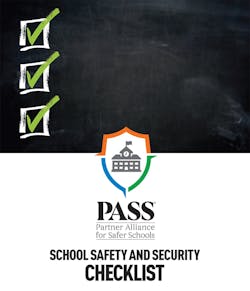New PASS School Security Guidelines Include Emerging Tech
This article appeared in the June 2023 issue of Security Business magazine. When sharing, don’t forget to mention Security Business magazine on LinkedIn and @SecBusinessMag on Twitter.
Deciding on the best and most effective way to approach safety and protecting students both outside and inside the classroom is a daunting task, especially with the mountain of information, products and advice coming at school systems from myriad sources.
Thankfully, a 501c3 nonprofit organization, the Partner Alliance for Safer Schools (PASS), was established in 2014 to bring together expertise from the education community, public safety and the security industry to develop and support a coordinated approach that can assist school administrators in making effective use of proven security practices specific to K-12 environments.
The sixth-edition release – including updates to the Safety and Security Guidelines and the School Safety and Security Checklist – improves on previous versions of the PASS guidance to make it more streamlined, easier to use and more reflective of K-12 schools’ evolving security needs and challenges.
PASS school security and safety guidelines are a key tool for integrators, who can provide them to school administrators, school boards and public safety and security professionals to help create a roadmap for implementing a layered and tiered approach to enhancing the safety of school environments, prioritizing needs, and making the most effective use of resources available.
It Takes a Village
In 2020, the PASS Advisory Council was formed to incorporate a broad range of stakeholder perspectives and expertise.
“We are totally agnostic when it comes to recommending solutions or types of products or technology,” explains K-12 school security consultant Guy Grace, a member of the Advisory Council and former Director of Security and Emergency planning for Littleton Public Schools in Colorado. “The minute we start becoming non-agnostic, we have lost all credibility, so we have embraced this notion of working as a group toward this greater goal of providing school safety recommendations.”
“Schools are getting bombarded with people coming at them with [different] solutions,” explains fellow Advisory Board member Mark Berger, president of lock provider Securitech. “PASS gives [them] a foundation and then a way to take it up level by level. There is no one-size-fits-all in the security world and especially in schools. There are multiple doors, multiple locking scenarios, for example, that need to be addressed.”
Changes in the Sixth Edition
The emphasis for the new edition of the guidelines was “getting back to basics,” Grace explains. “Building security with access control andThe sixth-edition guidelines feature more focused best practice recommendations to identify needed areas of improvement by separating the tier continuum practices that are already required by federal law or regulation or are already uniformly implemented throughout the U.S. For example, the new edition has redesignated tiers for clarity, which recommends that all schools and districts work toward Tier One measures regardless of location, budget or risk profile. If Tier One measures are in place, all should work towards Tier Two. Tiers 3 and 4 measures may be needed depending on a risk assessment; however, these technologies are outlined in more depth within the guidelines’ new “enhanced technologies” section.
The guidelines describe approaches within five physical layers for school facilities: districtwide, the property perimeter, the parking lot perimeter, the building perimeter and the classroom/interior perimeter. Within each layer, the resource outlines key safety and security components, such as policies and procedures, people (roles and training), architectural components, communication, access control, video surveillance and detection and alarms.
In Focus: Classroom Doors
Because the PASS Guidelines look at security from a layered perspective, they enable schools to easily breakdown each layer from the outside perimeter to the classroom itself. The guidelines feature several changes and enhancements to security of the classroom door, and is simplified and updated with current terminology, illustrations and recommendations consistent with modern, code-compliant door hardware and access control equipment.
“Traditional classroom function and storeroom function locks that limit locking and unlocking control to staff no longer meet current best practice guidelines for school security,” says Ken Cook, Director of National School Safety and Advocacy for Allegion, who also serves on the PASS Advisory Council.
One of the lessons learned from the last edition of the standards is how easily schools were able to override or compromise the traditional classroom function and stroreroom function locks via magnets and other methods.
“It is absolutely critical going forward that all occupants are able to lock a door in an emergency,” Grace says. “The way you can do that is by having locks and levers or pushbuttons that are code compliant.”
Grace went over many instances during past school shootings where lives could have been saved if students had had the ability to lock the doors during an emergency. Both Grace and Berger disagree with the argument that students will take advantage of the ability to lock the door during a non-emergency, because given the proper training and guidance, the result – better safety – is something that they have seen makes an impact on students, providing a better sense of overall security and control.
“We have learned the hard way that it is so important when we give staff and students that ability, that we empower them,” Grace asserts.
Enhanced Technologies Added
The new Enhanced Technologies section in the sixth edition details solutions under consideration by many schools and districts that show potential for making significant improvements to school safety but may not yet be widely adopted. These include newer technologies in the areas of weapons detection, analytics, emergency communications and biometrics.“There's a lot of higher-end technology and some great technology advances that are proving to be effective, so the new guidelines help make sense of this new technology,” says Berger, who added that he is excited by what he has seen in the areas of predictive analytics software and video surveillance systems.
Grace is equally excited about the addition of the enhanced technologies section, noting some of the advancements in analytics and prohibitive items detection as an example: “I have a feeling that section is going to be growing every year,” he says, “because there are all kinds of new technologies that are emerging.”
Here’s a quick look at what technologies are covered in each new section:
Weapons and Threat Detection: The guidelines cover traditional walk-through and hand-held metal detectors, but also include a section on passive detection technologies, such as terahertz, millimeter wave and video analytics. The caveat, according to the guidelines is the “human factor,” which is critical. “Implementation should support clearly communicated district-wide policies on what is permitted on campus and should be accompanied by clear procedures and staff training regarding the response when a prohibited item or threat is detected,” it says.
Vape Detection: Vape detection technology is now available that utilizes sensors resembling smoke or carbon monoxide detectors that can be used in places such as bathrooms or confined areas. Currently most of the providers of vape detectors offer a service that will send a text notification to designated staff when there is a detection. An effective best practice in conjunction with vape detectors is ensuring that there is camera coverage of the hallways outside of restrooms or entrances where this activity commonly occurs. Sensors should be hardened against vandalism and deployment should be accompanied by other procedures to counter efforts to defeat or disable them, such as sealing or alarming any restroom windows.
Electronic Hall Passes: These systems typically allow students to use electronic devices to submit requests for hall passes more freely and conveniently. When a request is submitted electronically, the teacher can quickly approve or deny the request with less classroom disruption and more time on tasks. Administrators can enter the names of students who are not supposed to have contact with each other, so the system will not approve requests from either student if the other student is out of class with a pass.
Analytics: Beyond video analytics capabilities, this section focuses on audio analytics for gunshot detection, glass breaks and voice analysis for aggression or panic. This technology can be loaded directly on cameras (as most network cameras already include a microphone), providing a dual-sensor technology capability within the same coverage area, or by using standalone devices. Other gunshot detection technologySpeeding vehicle analytics coupled with video management systems, which can be helpful in detecting dangerous driving behaviors, as well as license plate recognition, is also covered in the new section.
Biometrics: While the primary rationale for use of biometrics by a school or district is to streamline administrative functions requiring identity verification and enhance data security (such as account access), there are physical security applications as well. As with many industries, biometric readers can reduce or eliminate the need for (and expense of) using cards and keys or remembering PINs and account numbers. Biometrics-based check-in for transportation pick up/drop off for example, works the same as card-based check-in but may offer a more reliable process without the need for the student to remember and carry an ID card.
Mobile Duress Systems: Because reliability can be a matter of life and death, the wireless backbone of a mobile duress system must be fully supervised and able to withstand interference, overcome obstacles, and guarantee multiple paths from the alarm device to the receiver, and removed from the common faults and down times that cellular connections suffer from. Multiple wireless radio component capabilities for supervision and monitoring provide redundancy that can overcome a single point of failure.
“Before you go and buy these enhanced technologies, ask yourself if you addressed all the basics,” Grace says. “Did I do a risk assessment? Did I implement my locks and my access control? Did I put my cameras in the places that needed them? Those are the things that we're trying to emphasize with PASS.”
Raising Awareness
While school tragedies continue to happen at a disturbing and mind-numbing rate, awareness around school safety and security has “improved drastically,” Grace says. But with so much information and technology being given to schools, Grace implores those in charge of making these decisions to do their homework before making any big technology purchase.
“They need to educate themselves on what they are going to purchase and bring in their schools,” Grace says. “Schools need to make sure they are doing it in a comprehensive, holistic way, and they are not doing it in a way that turns a school into a prison.”
The PASS guidelines, checklist and other informational resources are available at https://passk12.org.
Paul Ragusa is Senior Editor for Locksmith Ledger magazine, a sister publication to Security Business. Visit www.locksmithledger.com for more.Coming in October: School & Campus Security & Safety Month
Four-part webinar series
The Partner Alliance for Safer Schools (PASS) has partnered with the Security Industry Association (SIA), Security Business, SecurityInfoWatch and American School & University magazine to bring you a four-part school security webinar series scheduled for every Tuesday in October (starting Oct. 10)!
- Emergency Preparedness (Oct. 10): Active shooter prevention, mass notification, evacuation and more (hosted by PASS & SIA).
- Building Security (Oct. 17): Access control, video surveillance, panic alarms, lockdowns, vulnerability assessments and more.
- Community Engagement (Oct. 24): School security starts with clear communication among administrators, teachers, parents, students, SROs and first responders (hosted by PASS & SIA).
- Roundtable – Lessons Learned (Oct. 31): A security & risk roundtable on campus safety.
Sign up for any or all of them today at www.securityinfowatch.com/SchoolSecurityMonth.
About the Author

Paul Ragusa
Paul Ragusa is senior editor for Locksmith Ledger International, an Endeavor Business Media Security publication.



